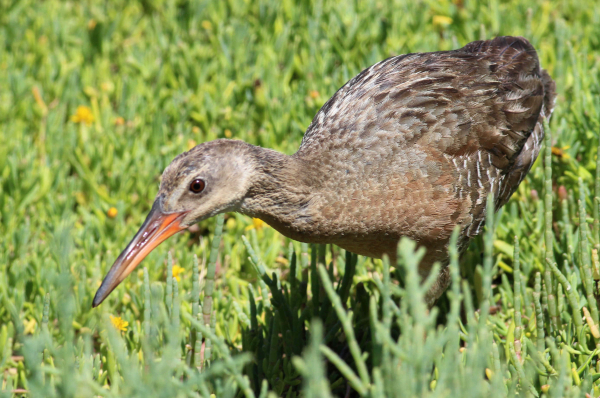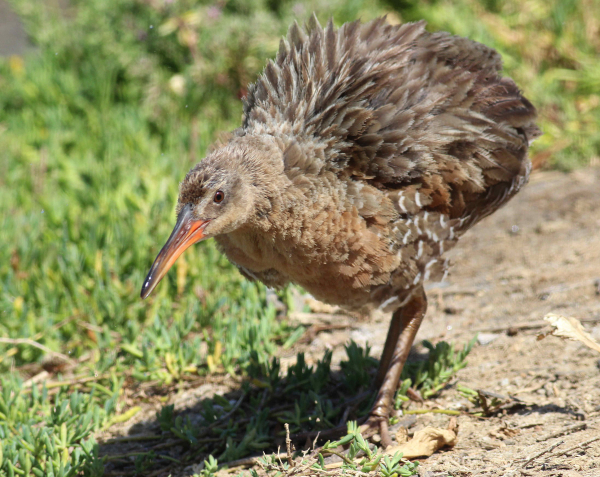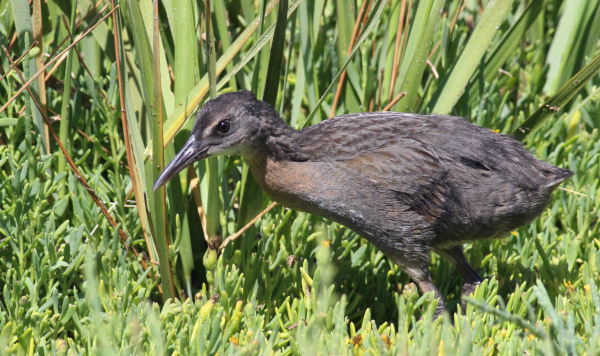As a rule, we often overlook rails as photo subjects, which is fairly understandable because rails tend to be very secretive; they rarely slip out of the thick cover they prefer. Rails are not common and in some cases, species are quite rare – even endangered – and they are very wary. If you see a rail, it’s usually for a such a short moment that it doesn’t lend itself to take a photo or a series of photos of the bird.

Along the tidal wetlands adjacent to the Pacific Coast, the Light-footed Ridgway’s Rail, formerly named and classified as the Light-footed Clapper Rail, is very rare; in fact, the subspecies is listed as endangered by the US Fish & Wildlife Service. They became the ‘white whale’ of southern California during the decades I lived there, until they suddenly began to show themselves at my favorite local birding hotspot: Bolsa Chica Wetlands, located on the north end of Huntington Beach.
Bolsa Chica is a great place to walk along a boardwalk and dikes that lead you through the tidal wetlands that attract a variety and abundance of wintering, migrating, and nesting birds as well as resident species including Light-footed Ridgway’s Rails. Even so, it took years just to see one, and longer to photograph one of these elusive rails. Finally, probably due to an increased population size, along with the eventual habituation of some individual rails to the many people walking through the miles of trails that lead through this popular birding hotspot.

After years of photographing at Bolsa Chica, it was especially exciting the first time a Ridgway’s Rail poked its head above the emergent plants that surround most of the wetland shores. “Wow, that’s a rail,” I thought as I raised my camera in anticipation for the rail’s next move after it slipped back behind the green curtain. But that was the only look I had that day, with a few similar glimpses from time to time. On a sunny Sunday morning a rail stepped into full view and walked along an exposed clam bed during a low tide period, searching for edible animals with each step, but yielding only a documentary photo.

Periodic sightings and documentary photographs eventually led to a breakthrough photo opportunity when I followed the progress of a Light-footed Ridgway’s Rail as it waded along the edge of shallow water shoreline during a morning high tide. This time the rail was moving steadily in my direction, which froze me in my tracks as I began to follow the rail’s progress through the 400mm telephoto lens attached to my camera. Partly afraid of what might happen if the rail dipped into the vegetation rather than progressing along the shoreline in my direction, I continued holding my breath as I took a couple documentary photos, touching the shutter button with crossed fingers for luck..
Then it happened; instead of continuing on its shoreline walk, it ducked into the vegetation – darn. But wait! Just as quickly as it disappeared behind the plants, it emerged into an opening almost at my feet – well, about 20 feet away. Undaunted by my presence, the rail walked all too quickly toward me and I continued to focus and re-focus on the rail, trying to keep it in my photo frame as it poked its head this way and that as it searched for a small crab or big bug. It kept coming, with me following its every move and pressing the shutter button whenever it turned into the sunlight; and then it stopped abruptly.
In that moment it stretched its beak, head, and neck forward; expanded its body plumage outward from its body, and gave a shaking shiver, known better as a “ruffle,” common among birds and mammals to get their feathers or hair into a comfortable position. From the moment it stopped I was photographing the sequence and continued as the trusting rail moved forward and eventually passed by me, just a few feet away! “WoW, that was remarkable,” I thought!

But the rail turned back to the water’s edge and after a few moments I backed away to try to reposition ahead of the rail, anticipating it to continue along the shoreline. But then, it snapped its beak forward with a small crab in its grasp. A second later it was out of sight again, and that was the end of one of my best rail photo episodes – memorable to say the least!
With time, I had opportunities to photograph rails periodically, and then a second episode began when 2 small black downy rails followed an adult on a hunting search along an open shoreline. I found that the young rails grew and matured quickly, with their black coloration yielding to dark gray as the first brown feathers began to show. At that point they could be seen hunting on their own at times, providing more rails to photograph when they showed themselves during my weekend visits to Bolsa Chica.

Dakota Rails
These days I’m far beyond the West Coast range of Light-footed Ridgway’s Rails, but there are still local rails in my neighborhood during migration and nesting seasons. Soras are fairly common, but like all rails they are exceptionally wary and usually hidden behind wetland plants. I hear Soras often, but photographing them is always a rare and celebrated moment. One other species of rails can be encountered here, Virginia Rails, but they are exceptionally rare and even more exceptionally hard to see in the open – once per year maybe, and to photograph one has been impossible to date.
As with so many birds, it becomes a matter of waiting for a rare sighting and being ready for a photo opportunity – some day, some year – while continuing to frequent habitats where the birds are heard, and hoping to see one step into the open on a sunny morning or afternoon. Frankly, I hope you have better luck than I’ve had with photographing rails, but we all need some hard to find, hard to photograph birds that keep birding interesting, and make it so very exciting when we connect with them through our camera lens. Good Luck!
Article and photographs by Paul Konrad
Share your bird photos and birding experiences at editorstbw2@gmail.com